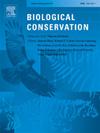Sustainability and avian biodiversity tensions in wastewater management in arid zones
IF 4.9
1区 环境科学与生态学
Q1 BIODIVERSITY CONSERVATION
引用次数: 0
Abstract
Biodiversity is increasingly threatened by anthropogenic and climatic changes around the globe. Many animals lose the habitats where they can settle and reproduce successfully or are affected in their migratory movements due to disturbance and a lack of stop-over sites. For instance, wetlands are declining worldwide with strong impacts on millions of resident and migratory birds relying on them. Artificial wetlands, such as wastewater treatment ponds can serve an important role in meeting habitat needs of wetland and water-dependent birds. Yet these sites are also altered by technological upgrades geared to more efficient water usage, with largely unknown consequences for avian biodiversity. Here, we systematically determine the relationship between wastewater treatment plants (WTPs) and avian biodiversity across various levels of technological WTP advancement, along the Nile in Egypt, which is a major bird migration flyway. We show that WTPs host large numbers of resident and migratory birds, however the most advanced treatment technologies have significantly lower abundance, species richness and species diversity compared to less advanced WTPs. In contrast, lower-technology WTPs with water availability and spill-over ponds and with a presumably higher water quality displayed higher species diversity. WTP type also affected the avian community composition, with smaller and less diverse species communities in the technologically most advanced WTPs with no open water surface. The results underscore ecological trade-offs associated with water-saving technologies, especially in arid regions where natural wetlands are limited or absent. We advocate for a balanced approach to wastewater management that integrates human resource efficiency and biodiversity conservation. Our findings have broader implications for trade-offs in resource management, emphasizing the need for multi-stakeholder involvement and nature-based scientific approaches. Our study lays the groundwork for establishing wastewater treatment policy that meets both the needs of humans and of wildlife, and more broadly, how wastewater treatment can contribute to biodiversity conservation and meeting sustainable development goals.
干旱区废水管理中的可持续性和鸟类生物多样性紧张关系
全球生物多样性正日益受到人为和气候变化的威胁。许多动物失去了它们可以成功定居和繁殖的栖息地,或者由于干扰和缺乏中途停留地点而影响了它们的迁徙运动。例如,世界范围内的湿地正在减少,对数百万依赖湿地的候鸟和留鸟产生了强烈影响。污水处理池等人工湿地在满足湿地和水依赖鸟类的栖息地需求方面发挥着重要作用。然而,为了更有效地利用水资源而进行的技术升级也改变了这些地点,这对鸟类生物多样性的影响在很大程度上是未知的。在这里,我们系统地确定了污水处理厂(WTP)与鸟类生物多样性之间的关系,这些关系跨越了污水处理厂技术进步的不同水平,沿着埃及的尼罗河,这是鸟类迁徙的主要途径。研究表明,wtp是大量候鸟和留鸟的栖息地,但最先进的处理技术在丰度、物种丰富度和物种多样性方面都明显低于较不先进的wtp。相比之下,具有水可用性和溢出池以及可能具有较高水质的低技术wtp显示出更高的物种多样性。WTP类型也影响鸟类群落组成,在技术最先进的WTP中,没有开放水面的物种群落规模较小,多样性较低。研究结果强调了与节水技术相关的生态权衡,特别是在自然湿地有限或缺乏的干旱地区。我们提倡采取一种综合人力资源效率和生物多样性保护的平衡方法来管理废水。我们的研究结果对资源管理的权衡具有更广泛的意义,强调了多方利益相关者参与和基于自然的科学方法的必要性。我们的研究为建立既满足人类需求又满足野生动物需求的废水处理政策奠定了基础,并从更广泛的角度探讨了废水处理如何有助于生物多样性保护和实现可持续发展目标。
本文章由计算机程序翻译,如有差异,请以英文原文为准。
求助全文
约1分钟内获得全文
求助全文
来源期刊

Biological Conservation
环境科学-环境科学
CiteScore
10.20
自引率
3.40%
发文量
295
审稿时长
61 days
期刊介绍:
Biological Conservation is an international leading journal in the discipline of conservation biology. The journal publishes articles spanning a diverse range of fields that contribute to the biological, sociological, and economic dimensions of conservation and natural resource management. The primary aim of Biological Conservation is the publication of high-quality papers that advance the science and practice of conservation, or which demonstrate the application of conservation principles for natural resource management and policy. Therefore it will be of interest to a broad international readership.
 求助内容:
求助内容: 应助结果提醒方式:
应助结果提醒方式:


